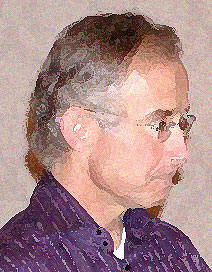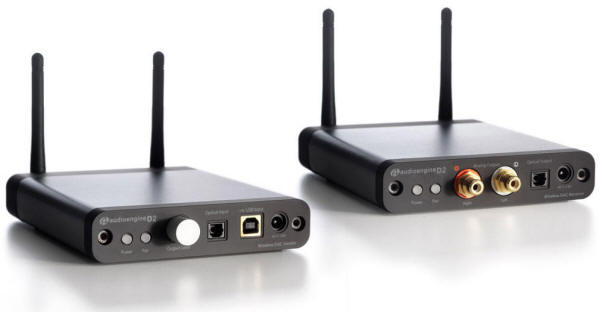|
You are reading the older HTML site
Positive Feedback ISSUE 60
The Neoteric Listener and the Audioengine D2
Wireless DAC
Readers of this column know that I have often lauded Audioengine for producing affordable, great sounding products that appeal to audiophiles and non-audiophiles alike. At a buck shy of six hundred dollars, however, the Audioengine D2 Premium 24-Bit Wireless DAC is probably meant for, well, someone who knows the value of a premium 24-bit wireless DAC. For those who don't, Audioengine will soon offer their new W3 wireless DAC, which will be 16-bit and undoubtedly much lower priced. As it is, the D2 is now in direct competition with a number of excellent, albeit wingless, DACs which offer superb sound for the money. Moreover, the stat sheet for the D2 shows that it processes up to 24-bits and 192kHz sample rate then transmits it wirelessly at 24/96kHz. And the thing that you're hearing is only the sound of the wailing of spec-graph boys… All right, let's get it out of the way early. Anticipating the criticism of those keeping score with their audio calculator, I emailed Brady Bargenquast, Audioengine co-founder, asking him why the D2 was not designed to be a straight 24/192 wireless USB DAC. He replied, "The Burr-Brown PCM1792 DAC can do 192kHz which gave us the option to upsample to 192 on the receiver side, but we decided against this as the noise levels measured higher than what we thought was acceptable (and figured bit-perfect 24/96 from start to finish was the better feature as 24/96 is more popular than 24/192)." This works for me, as my limited collection of high resolution files are mainly 24/96, and I can agree that listening to 24/192 files with any noise seems to defeat the purpose. I suspect that Audioengine had to also contend with the usual price point/technology challenge, given that wireless computer audio is still the province of mountain men and pioneers, but this is my conjecture only, and not verified by those in the know. At any rate (no pun intended, for a change), those who do have a wealth of 24/192 files that simply must be streamed wirelessly at native resolution might feel a little left out by the D2. Not to worry, though, as this DAC proves to be admirably suited for producing absolutely lovely sounding music from files both small and tall.
Did I just give the review away? Shoot, well, I might as well start with a little backstory. The now-retired Audioengine W1 wireless DAC has been a mainstay of my bedroom system for almost a year now, and it has served its purpose wonderfully well. I enjoy listening to music when sorting the laundry or shouting my particular wisdom and weirdness throughout the house. During these performances, I'm listening to music at my ease, and I'm not overly fussy that I'm exacting the very last degree of tonal accuracy or resolution from a wireless system. The W1 sounds perfectly fine and hardly ever drops out, and is well worth the hundred bucks for the service. As stated, I don't have a huge collection of high-res files, although that number is growing rapidly as major record labels exhume the mausoleums that entomb the heroes of my youth, so why would I need a DAC that can transmit my pricey downloads through my kitchen and into the (not-so-far) recesses of the shack? Short answer, this DAC sounds great, and the wireless part is just a splendid bonus. Those who have been lucky enough to hear the Audioengine D2 seem to agree on its sound: rich, musical, and powerful, especially in the lower and midrange frequencies. Unlike the sparkle and warmth that you get from, say the Grant Fidelity DAC-11 that I reviewed earlier this year, the D2 gives a more evenhanded, realistic rendering of music. It may not have the firm grip and precision of the CEntrance DACmini PX when playing computer files, but it wouldn't surprise me if many people don't prefer the Audioengine's smooth touch with even the prickliest recordings. Detail retrieval is excellent, especially with voices and stringed instruments, and it's extraordinary how much force this wireless DAC conveys with instruments such as a kick drum or Fuzztone bass. Going back and forth between the CEntrance and the Audioengine illustrates the artistry of digital design, where subtle points of emphasis define the overall sonic character of the machine. So which DAC is better? Which one sounds more real? You might as well ask the same question about various amplifiers, phono stages, or speakers. As usual, it's all about what you hope the machine will do for your audio experience. The CEntrance PX provides marvelous detail and accuracy without sounding clinical; the Audioengine D2 presents a full, sensuous sound that is universally appealing and effortlessly enjoyable. One thing that is true, it's obvious that both companies are able to make DACs that sound worlds better and are much cheaper than could be found even two years ago. Paired with the Arcam A80 and Tannoy Eyris I's, the Audioengine gives much needed polish to a system that doesn't always mesh well with digital files. Paired with the Peachtree Audio iNova, Nola Contender speakers, and Kubala-Sosna Imagination speaker cables, the D2 sounds almost too rich, especially in the midrange. Switch out the Kubala-Sosna cables for a pair of WyWires Silver Series speaker cables (review pending), and the system comes into balance and performs beautifully. The D2's major strength as a DAC is that it shows all your files to their best advantage, and even rotten ones have a certain Falstaffian charm. It's hard to describe why this is, as the Audioengine never resorts to the old trick of rounding off tones, softening note attack, exaggerating soundstage, and juicing the midrange, at least, that's not how I hear it. I would say the D2 is just as resolving as almost any DAC I've auditioned, but it's done so in proportion to the overall sound, and, thus, doesn't draw attention as being noticeably artificial. It's clear that the Audioengine D2's sophisticated blend of detail retrieval, timing, and tonal shading makes you feel you're getting your money's worth from high-res files and a great deal more than that from 16-bits and 44.1kHz. The Audioengine D2 consists of two parts, a Sender that can be powered via an external power adapter or directly from the USB bus, and a Receiver, which is connected via the RCA Stereo or Optical (SPDIF) outputs and powered by an AC power cord. I didn't notice much, if any, difference between the USB and external power option, so feel free to carry the Sender with you, if your laptop is the restless type. In layman's terms, the Sender gathers up all the file data and gets it ready to travel, then sends it out to the Receiver where it arrives as the perfect little asynchronous package for your amplifier and speakers to open and share. The D2 is not only a wireless USB DAC, but you can use it as a 24-Bit USB-to-SPDIF converter for wireless operation of your existing DAC, merely by connecting the USB input to the Sender and the D2 optical output to your DAC. Rather than butcher the technical explanation of the D2's wireless mechanism, I'll defer to the Audioengine website: "The D2 sends a 24-bit/96kHz PCM stereo digital stream over-the-air in a "closed-system" Wi-Fi configuration. The system's proprietary RF technology ensures data integrity with no impact on existing routers or networks. The volume control on the D2 Sender is transmitted over an entirely separate channel so there is no impact on the digital audio stream." The wireless range of the Audioengine D2 is claimed to be 30 meters, that's roughly 100 feet, American, so I put it to the test. Decades ago, I bought a wireless transmitter/receiver for gigs at bleary late night dives. I'd keep it hidden for the first two sets, wait until just about scotch o'clock, and then sprint mid-solo through the bar and out the door, still playing. It always got a big whoop from the crowd (although, by that time, pretty much anything got a throaty shout), but it did require that I test the darn thing so as not to be seen as a complete loser if the wireless crapped out when I got out of range. With this experience still loosely in my memory, I connected the Sender to my MacBook and placed the D2 receiver at the farthest end of the house to see if there were any detectible changes or dropouts. None. It worked perfectly. Of course, while the shack I live in may have seemed big to the goats for which it was constructed, nobody without hooves would think so. Grabbing the MacBook Pro and the Sender powered via the USB bus, I turned up the iNova, closed the front door, and started walking. In the yard, all sounded fine, in the driveway, still going, on the sidewalk, you could still hear the Civil Wars EP. Would it even work across the street, in the car, with the door closed and window down? Ok, nope, but back on the sidewalk, listening to ridiculously loud uninterrupted music made me a believer that the Audioengine D2 could be a viable wireless option for all but the most palatial dwellings. High end audio has a lot in common with the travel industry. Both provide a getaway to somewhere way the hell away from all the stuff that you have to do or solve or think about or clean up. But when money's short and travel's out, it's nice to have a wireless system that transports favorite selections to a back patio, secluded garden spot, or listening area where a person can have a little uninterrupted peace and music. For those who just want to stream wirelessly so as to remove a noisy computer from the main system, the D2 should be just the thing. In my case, my innate obstinacy precludes me from doing the sensible thing and running a Mac mini with my main system. Instead, my MacBook Pro is in my lap, connected directly to the Peachtree iNova's USB input via a long usb cable or to the CEntrance DACport using a long cable specially made by the wizards at Zu Audio. It all sounds fine, but yanking the audio i.v. tube around whenever I want to listen to my latest Blue Coast records download is drag. I don't use this recliner's delight setup for critical listening, naturally, but I do it enough to ruin both USB ports (I first thought that the D2 was suffering from dropouts until I realized that it was the USB cable shorting out). The Audioengine D2 has momentarily freed me from my mondo bondage, and that right there deserves a special commendation. For those with lots of rooms and audio setups (lucky!), there is the option of streaming high definition audio to multiple systems. The Audioengine D2 can stream high definition audio to up to three Receivers (currently at $349 apiece). This is getting ridiculous. Even though I can hear the taunts of "Fanboy!" from here, I'm still going on record that Audioengine has delivered yet another excellent audio product at a very competitive price. If you're looking for a great sounding DAC, then this one is a fine choice, and if a wireless DAC is something that you are searching for, then the Audioengine D2 is just the thing.
Audioengine D2 Premium
24-Bit Wireless DAC
|


